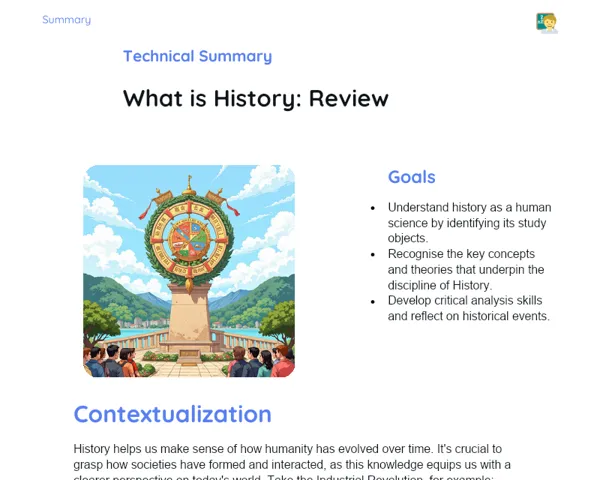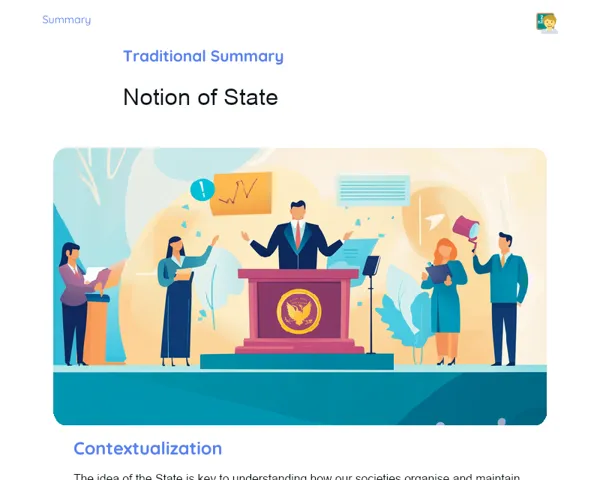Summary Tradisional | Chinese Communist Revolution
Contextualization
The Chinese Communist Revolution, which culminated in 1949, was a pivotal event that transformed China into a socialist republic under the leadership of the Chinese Communist Party (CPC). This revolutionary movement emerged from decades of political, social, and economic tensions that began in the early 20th century. During this time, China grappled with numerous challenges, such as oppressive imperial rule, foreign exploitation, social inequality, and widespread poverty. The introduction of communism offered a potential resolution to these issues, presenting a vision of equality and progress for all Chinese citizens.
The downfall of the Qing Dynasty in 1911 and the establishment of the Republic of China signalled the start of a tumultuous period marked by instability and conflict. The civil war between the Kuomintang (KMT) and the CPC, worsened by the Japanese invasion during World War II, intensified the internal strife. The CPC, spearheaded by Mao Zedong, advocated for agrarian reforms and social equality, gaining significant support from peasants and workers. In 1949, after years of struggle, the CPC declared the establishment of the People's Republic of China, ushering in a new era of communist policies that focused on land redistribution, gender equality, and social and economic development.
To Remember!
Historical Context (1911-1949)
The historical context surrounding the Chinese Communist Revolution is marked by significant instability and transformation. With the overthrow of the Qing Dynasty in 1911, imperial rule came to an end, paving the way for the Republic of China. However, the new republic was beset by challenges, including political fragmentation and power struggles between various factions. The Kuomintang (KMT), under Chiang Kai-shek, and the Chinese Communist Party (CPC), led by Mao Zedong, emerged as the principal opposing political entities.
The civil war that erupted between the KMT and the CPC started in the 1920s and continued sporadically until the conclusion of World War II. The Japanese invasion in 1937 aggravated the internal conflict, prompting a temporary alliance between the KMT and the CPC to combat this shared enemy. Following Japan's defeat in 1945, the civil war resumed with renewed ferocity. The CPC, benefitting from strong support among peasants and effective military strategies, gradually gained the upper hand against the KMT.
By 1949, the CPC emerged victorious over the KMT, establishing the People's Republic of China, with Mao Zedong as its leader. The remnants of the KMT retreated to Taiwan, where they set up a rival government. This victory signalled the beginning of a new chapter in Chinese history, culminating in profound political, social, and economic changes.
-
Fall of the Qing Dynasty in 1911 and the establishment of the Republic of China.
-
Civil war between the Kuomintang (KMT) and the Chinese Communist Party (CPC).
-
Japanese invasion and temporary alliance between KMT and CPC.
-
Proclamation of the People's Republic of China in 1949.
Motivations of the Revolution
The motivations behind the Chinese Communist Revolution were complex and multifaceted, reflecting the deep-seated inequalities and social tensions prevalent in early 20th century China. Foreign exploitation represented one of the main drivers, as Western powers and Japan exercised economic and territorial control over various regions of China. This foreign domination fostered a sense of nationalism and the aspiration to expel the invaders.
Social inequality and severe poverty were also critical factors contributing to the revolution. A large portion of the Chinese populace comprised impoverished peasants struggling to make ends meet, often lacking access to land or sufficient resources. The nationalist government led by the KMT failed to effectively tackle these pressing issues, resulting in growing discontent among the masses. The Chinese Communist Party (CPC) adeptly capitalized on this disillusionment, pledging agrarian reform, land redistribution, and social equality.
Furthermore, the rampant corruption and inefficacy of the KMT government heightened support for the CPC. The CPC presented itself as a morally superior alternative, committed to fighting exploitation and oppression. Thus, the allure of communism, with its promises of social and economic justice, resonated with many Chinese, particularly peasants and workers.
-
Foreign exploitation and economic domination.
-
Social inequality and severe poverty.
-
Dissatisfaction with the nationalist government's inefficiency.
-
CPC's promises of agrarian reform and social equality.
Influence of the Soviet Union
The Soviet Union played a pivotal role in the Chinese Communist Revolution by providing military, financial, and ideological support to the Chinese Communist Party (CPC). Since the 1920s, the Soviet Union viewed China as a potential ally in the struggle against Western imperialism and capitalism. The Comintern (Communist International), a Soviet-led organisation, was instrumental in establishing the CPC and offered training and resources for its leaders.
During the civil war, the Soviet Union extended logistical and military assistance to the CPC, particularly after World War II. The Sino-Soviet alliance was formalised in 1950 through the signing of the Treaty of Friendship, Alliance, and Mutual Assistance. This treaty ensured ongoing Soviet support for the new People's Republic of China, aiding it in consolidating power and implementing communist policies.
Additionally, the Soviet Union served as a model for communist governance in China. The policies of collectivisation and central planning adopted from the Soviet experience influenced the economic and social practices of the CPC. However, this relationship was not without its tensions; ideological and political rifts emerged in subsequent years, eventually resulting in the Sino-Soviet split during the 1960s.
-
Military, financial, and ideological support from the Soviet Union to the CPC.
-
Formalisation of the Sino-Soviet alliance through the 1950 treaty.
-
Adoption of Soviet collectivisation and planning principles.
-
Emergence of ideological and political tensions leading to the Sino-Soviet split.
Social and Economic Problems
Prior to the Communist Revolution, China was plagued by a host of pressing social and economic issues that contributed to widespread discontent and paved the way for support of the Chinese Communist Party (CPC). Famine was a frequent crisis, worsened by inadequate agricultural infrastructure and the exploitation of impoverished peasants by wealthy landowners. Income inequality was stark, with a small elite hoarding the bulk of the nation's wealth.
Corruption was rife within the nationalist government of the Kuomintang (KMT), eroding public trust and hampering administrative efficiency. The lack of investment in essential infrastructure—such as roads, schools, and hospitals—stymied opportunities for both social and economic advancement. The rural population, in particular, bore the brunt of this neglect, struggling to access basic services and pathways for betterment.
The CPC vowed to tackle these pressing issues by implementing communist policies, including land redistribution and social reforms. Among the first initiatives adopted post-victory in 1949 was agrarian reform, which involved reallocating land from large landowners to peasants. Furthermore, the CPC promoted gender equality policies, advancing women's roles in both the workforce and political spheres, and prioritised education and public health to elevate the living standards of the populace.
-
Famine and lack of agricultural infrastructure.
-
Extreme income inequality and exploitation of peasants.
-
Corruption and ineffectiveness within the KMT government.
-
Implementation of communist policies for land redistribution and social reforms.
Results of the Revolution
The Chinese Communist Revolution culminated in the establishment of the People's Republic of China in 1949, signalling the onset of a new regime led by the Chinese Communist Party (CPC). One of the government's first actions was to carry out extensive agrarian reform, redistributing land from wealthy landowners to peasants. This initiative aimed to eliminate exploitation and mitigate social inequality, garnering widespread support from the rural community.
In addition to land redistribution, the CPC introduced policies to promote gender equality, encouraging women's active participation in the workforce and politics. Education and healthcare were given top priority, resulting in the construction of schools and hospitals in previously neglected areas. These efforts sought to elevate living standards and foster social cohesion, thereby consolidating the power of the new regime.
Despite these advancements, the application of communist policies encountered significant challenges. Initiatives such as collectivisation and rapid industrialisation, notably during the Great Leap Forward, resulted in severe economic and social difficulties, including famine and chaos. Nevertheless, the Chinese Communist Revolution laid the groundwork for modern China, profoundly shaping its political and economic direction in the decades that followed.
-
Proclamation of the People's Republic of China in 1949.
-
Initiation of agrarian reform and land redistribution.
-
Promotion of gender equality and advancements in education and public health.
-
Challenges stemming from collectivisation and rapid industrialisation policies.
Key Terms
-
Chinese Communist Revolution: Revolutionary movement leading to the establishment of the People's Republic of China under the CPC in 1949.
-
Chinese Communist Party (CPC): The political party that led the revolution and has governed China since 1949.
-
Soviet Union: The country that provided crucial military, financial, and ideological support to the CPC during the revolution.
-
Social inequality: A key motivation for the revolution, highlighting the significant disparity of wealth and power in Chinese society.
-
Extreme poverty: The dire condition faced by many Chinese peasants prior to the revolution, exacerbated by exploitation and lack of infrastructure.
-
Agrarian reform: A policy initiated by the CPC after 1949, involving the redistribution of land from wealthy landowners to peasants.
-
Communist policies: A suite of strategies adopted by the CPC to address social and economic challenges in China, including collectivisation and rapid industrialisation.
-
Land redistribution: The process of reallocating land from wealthy landowners to peasants, a key early initiative of the CPC.
-
Gender equality: A policy pushed by the CPC aimed at enhancing women's involvement in the workforce and political arena.
-
Social and economic problems: The challenges facing China prior to the revolution, including famine, infrastructure deficits, corruption, and income inequality.
Important Conclusions
The Chinese Communist Revolution, culminating in 1949, was a profoundly transformative moment in Chinese history, resulting in the founding of the People's Republic of China under the leadership of the CPC. This revolutionary movement arose from decades of social inequality, foreign exploitation, and extreme poverty. The CPC's promises of agrarian reform and social equality garnered widespread support, significantly reshaping the country's political and social landscape.
The Soviet Union's influence was vital to the success of the Chinese Communist Revolution, offering military and ideological support to the CPC. The Sino-Soviet alliance, along with Soviet-inspired policies, played a crucial role in guiding the reforms implemented in China. However, ideological differences eventually surfaced, leading to the Sino-Soviet split.
The immediate outcomes of the revolution included land redistribution, the promotion of gender equality, and major advances in education and public health. Although implementing communist policies came with challenges, such as collectivisation and rapid industrialisation, the revolution laid the cornerstone for modern China, profoundly affecting its political and economic path in the years to follow. Understanding this historical event is essential for grasping contemporary China and the enduring impact of the revolution on Chinese society.
Study Tips
-
Read Mao Zedong's 'Little Red Book' to get a clearer picture of the ideology and policies promoted during the Chinese Communist Revolution.
-
Dig deeper into the civil war between the KMT and the CPC to enhance your understanding of the internal conflicts leading up to the revolution.
-
Check out documentaries and historical films that depict the Chinese Communist Revolution for a visual appreciation of the events and their cultural and social ramifications.



